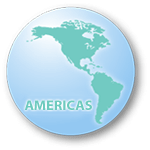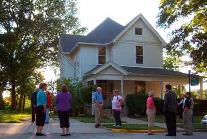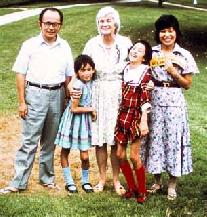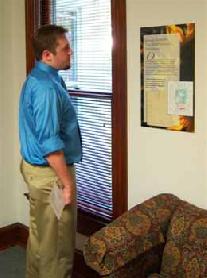AMERICAS
Peace Resource Center at Wilmington College (U.S.)
(Dec. 9, 2008)
by Charlotte Pack, Administrative Assistant
The Wilmington College Peace Resource Center provides peace strategies and hope-filled stories to a weary world in conflict. The Center offers an atomic bomb research collection, a bookstore, a peace education library, exhibits, and the Institute for Problem Solving. The Institute trains groups in peer mediation and teachers in Positive Discipline. In addition, the Institute works to integrate middle school clique groups through Project TRUST retreats.
Barbara Reynolds, a Quaker peace activist and American who had lived for more than 15 years in Hiroshima, started the Peace Resource Center in 1975 with a prayer for no more nuclear war. Moved by her convictions, Reynolds was resolved the world must learn the message of the Hibakusha (A-bomb survivors)--no more Hiroshimas or Nagasakis anywhere in the world. Twice she and her family sailed into restricted zones--one U.S. and one Russian--to protest the nuclear testing in these nations. Three times she traveled the world with groups of survivors, personally providing or raising most of the necessary funds herself. In 1975, she was named an honorary citizen of Hiroshima. At the time, she was only the fourth person and the first woman to be given that award.
Reynolds also believed friendship destroyed the stereotypes on which wars are based, and that a center where people from different countries could meet and learn about each other was one way to develop peace. Putting this belief into action, in 1965 she founded the World Friendship Center in Hiroshima in an effort to build “bridges of friendship and to encourage people of every nation to become peacemakers.”
Reynolds returned to the United States in 1969 to find a home for her research collection. In August 1975--the 30th anniversary of the atomic bombings--Reynolds and Wilmington College established the Peace Resource Center on campus featuring the Hiroshima/Nagasaki Memorial Collection. At the same time, the Center sponsored the 30 Years After Conference with speakers from several nations talking about the past, present, and future state of nuclear weapons.
Reyonold's collection of documentary films, books, and research files from the 1940s through the 1970s provided the groundwork for the world's largest collection (outside of Japan) of reference and research materials related to the atomic bombings of Hiroshima and Nagasaki. Some examples of the collection's holdings include documents, letters and periodical files, photographs, and audio and film recordings of Hibakusha, Committee for A-Bomb Survivors in the United States, August 6/9 observances (1947-Present), Hiroshima /Nagasaki Bombing Publications (1940s-1980s), Development of the Atomic Bomb, The Effects of War, Medical Effects of Hiroshima/Nagasaki Bombing, the Hiroshima Peace Pilgrimage (1962), World Peace Mission (1964), World Friendship Center Records, and so forth.
Researchers from around the world have public access to the archives, English-language and Japanese-language libraries. The collection helps keep hope alive for a peaceful world as people are reminded of the cost of war and the triumph of the human spirit.
A permanent exhibit at the Center features “Stories of Hope,” four stories designed to inform and inspire, as well as illustrate how individuals can have an impact and, in some cases, change the world. The colored wall-mounted storyboards highlight Barbara Reynolds, founder of the Peace Resource Center; Sadako Sasaki, a young girl who died of leukemia induced by radiation from the atomic bombing of Hiroshima; the Hiroshima Maidens, a group of young Japanese women who came to the United States for reconstructive surgery following the bombings; and Dr. Takashi Nagai of Nagasaki, the first published writer of the A-Bomb experience. Nagai has been described as “a symbol of mercy and compassion” for his insightful writings, while the Hiroshima Maidens represent the remarkable story how, disfigured by the atomic bombing, they discovered forgiveness and renewed hope as a result of their visit to the United States. Sadako's story is among the best known. A child dying of cancer, she began folding origami “peace cranes” in accordance with the Japanese folklore that a wish would be granted upon the folding of 1,000 paper cranes.
Through its resources and programs the Center provides visitors and students with the opportunity to learn about peacemaking in their personal lives and in the world.
Address: Wilmington College, 1870 Quaker Way, Pyle Box 1183,
Wilmington, Ohio 45177, U.S.A.
Tel: +1-937-382-6661 extension 371
Homepage: http://www.wilmington.edu/the-wilmington-difference/prc/
Days closed: Saturday and Sunday, December 25 through January 1
Admission: Free, donations appreciated
(Originally published on December 1, 2008)
 Peace Museums of the AMERICAS
Peace Museums of the AMERICAS


